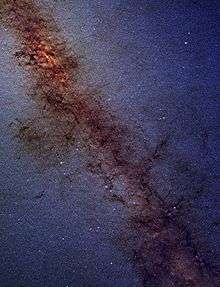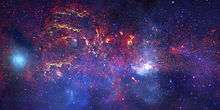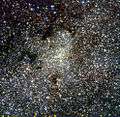Galactic Center


The Galactic Center is the rotational center of the Milky Way. The estimates for its location range from 7.6 to 8.7 kiloparsecs (about 25,000 to 28,000 lightyears) from Earth in the direction of the constellations Sagittarius, Ophiuchus, and Scorpius where the Milky Way appears brightest. There is strong evidence consistent with the existence of a supermassive black hole at the Galactic Center of the Milky Way.
Proof of existence and location
Because of interstellar dust along the line of sight, the Galactic Center cannot be studied at visible, ultraviolet or soft X-ray wavelengths. The available information about the Galactic Center comes from observations at gamma ray, hard X-ray, infrared, sub-millimetre and radio wavelengths.
Harlow Shapley stated in 1918 that the halo of globular clusters surrounding the Milky Way seemed to be centered on the star swarms in the constellation of Sagittarius, but the dark molecular clouds in the area blocked the view for optical astronomers. In the early 1940s Walter Baade at Mount Wilson Observatory took advantage of wartime blackout conditions in nearby Los Angeles to conduct a search for the center with the 100 inch Hooker Telescope. He found near the star Alnasl (Gamma Sagittarii) a one-degree-wide void in the interstellar dust lanes, giving a relatively clear view through the spiral arms of our Galaxy to the swarms of stars around the nucleus. This gap has been known as Baade's Window ever since. He was not satisfied that he had pinpointed the galactic center, and when the Mount Palomar telescopes were commissioned around 1950, he applied them to the task also, with no success.
At Dover Heights in Sydney, Australia a team of radio astronomers from the Division of Radiophysics at the CSIRO, led by Joseph Lade Pawsey, used a 'sea interferometer' to discover some of the first interstellar and intergalactic radio sources, including Taurus A, Virgo A and Centaurus A. By 1954 they had built an 80 feet (24.4 meters) fixed dish antenna and used it to make a detailed study of an extended, extremely powerful belt of radio emission that was detected in Sagittarius. They named an intense point-source near the center of this belt Sagittarius A, and realised that it was located at the very center of our Galaxy, despite being some 32 degrees south-west of the conjectured galactic center of the time.
In 1958 the International Astronomical Union (IAU) decided to adopt the position of Sagittarius A as the true zero co-ordinate point for the system of galactic latitude and longitude.[1] In the equatorial coordinate system the location is: RA 17h 45m 40.04s, Dec −29° 00′ 28.1″ (J2000 epoch).
Distance to the Galactic Center
The exact distance between the Solar System and the Galactic Center is not certain,[2] although estimates since 2000 have remained within the range 7.2–8.8 kpc.[3] The latest estimates from geometric-based methods and standard candles yield the following distances to the Galactic Center:
- 7.4±0.2(stat) ± 0.2(syst) or 7.4±0.3 kpc (≈24±1 kly)[3]
- 7.62±0.32 kpc (≈24.8±1 kly)[4]
- 7.7±0.7 kpc (≈25.1±2.3 kly)[5]
- 7.94 or 8.0±0.5 kpc (≈26±1.6 kly)[6][7][8]
- 7.98±0.15(stat) ± 0.20(syst) or 8.0±0.25 kpc (≈26±0.8 kly)[9]
- 8.33±0.35 kpc (≈27±1.1 kly)[10]
- 8.7±0.5 kpc (≈28.4±1.6 kly)[11]
An accurate determination of the distance to the Galactic Center as established from variable stars (e.g. RR Lyrae variables) or standard candles (e.g. red-clump stars) is hindered by countless effects, which include: an ambiguous reddening law; a bias for smaller values of the distance to the Galactic Center because of a preferential sampling of stars toward the near side of the Galactic bulge owing to interstellar extinction; and an uncertainty in characterizing how a mean distance to a group of variable stars found in the direction of the Galactic bulge relates to the distance to the Galactic Center.[12][13]
The nature of the Milky Way's bar, which extends across the Galactic Center, is also actively debated, with estimates for its half-length and orientation spanning between 1–5 kpc (short or a long bar) and 10–50°.[11][12][14] Certain authors advocate that the Milky Way features two distinct bars, one nestled within the other.[15] The bar is delineated by red-clump stars (see also red giant); however, RR Lyr variables do not trace a prominent Galactic bar.[12][16][17] The bar may be surrounded by a ring called the "5-kpc ring" that contains a large fraction of the molecular hydrogen present in the Milky Way, as well as most of the Milky Way's star formation activity. Viewed from the Andromeda Galaxy, it would be the brightest feature of the Milky Way.[18]
Supermassive black hole

The complex astronomical radio source Sagittarius A appears to be located almost exactly at the Galactic Center (approx. 18 hrs, −29 deg), and contains an intense compact radio source, Sagittarius A*, which coincides with a supermassive black hole at the center of the Milky Way. Accretion of gas onto the black hole, probably involving a disk around it, would release energy to power the radio source, itself much larger than the black hole. The latter is too small to see with present instruments.
A study in 2008 which linked radio telescopes in Hawaii, Arizona and California (Very Long Baseline Interferometry) measured the diameter of Sagittarius A* to be 44 million kilometers (0.3 AU).[19][20] For comparison, the radius of Earth's orbit around the Sun is about 150 million kilometers (1.0 AU), whereas the distance of Mercury from the Sun at closest approach (perihelion) is 46 million kilometers (0.3 AU). Thus the diameter of the radio source is slightly less than the distance from Mercury to the Sun.

Scientists at the Max Planck Institute for Extraterrestrial Physics in Germany using Chilean telescopes have confirmed the existence of a supermassive black hole at the Galactic Center, on the order of 4.3 million solar masses.[10]
On 5 January 2015, NASA reported observing an X-ray flare 400 times brighter than usual, a record-breaker, from Sagittarius A*. The unusual event may have been caused by the breaking apart of an asteroid falling into the black hole or by the entanglement of magnetic field lines within gas flowing into Sagittarius A*, according to astronomers.[22]
Stellar population
The central cubic parsec around Sagittarius A* contains around 10 million stars.[23] Although most of them are old red giant stars, the Galactic Center is also rich in massive stars. More than 100 OB and Wolf–Rayet stars have been identified there so far.[24] They seem to have all been formed in a single star formation event a few million years ago. The existence of these relatively young stars was a surprise to experts, who expected the tidal forces from the central black hole to prevent their formation. This paradox of youth is even stronger for stars that are on very tight orbits around Sagittarius A*, such as S2 and S0-102. The scenarios invoked to explain this formation involve either star formation in a massive star cluster offset from the Galactic Center that would have migrated to its current location once formed, or star formation within a massive, compact gas accretion disk around the central black-hole. Most of these 100 young, massive stars seem to be concentrated within one or two disks, rather than randomly distributed within the central parsec.[25][26] This observation however does not allow definite conclusions to be drawn at this point.
Star formation does not seem to be occurring currently at the Galactic Center, although the Circumnuclear Disk of molecular gas that orbits the Galactic Center at two parsecs seems a fairly favorable site for star formation. Work presented in 2002 by Antony Stark and Chris Martin mapping the gas density in a 400-light-year region around the Galactic Center has revealed an accumulating ring with a mass several million times that of the Sun and near the critical density for star formation. They predict that in approximately 200 million years there will be an episode of starburst in the Galactic Center, with many stars forming rapidly and undergoing supernovae at a hundred times the current rate. This starburst may also be accompanied by the formation of galactic jets as matter falls into the central black hole. It is thought that the Milky Way undergoes a starburst of this sort every 500 million years.
In addition to the paradox of youth, there is also a "conundrum of old age" associated with the distribution of the old stars at the Galactic Center. Theoretical models had predicted that the old stars—which far outnumber young stars—should have a steeply-rising density near the black hole, a so-called Bahcall–Wolf cusp. Instead, it was discovered in 2009 that the density of the old stars peaks at a distance of roughly 0.5 parsec from Sgr A*, then falls inward: instead of a dense cluster, there is a "hole", or core, around the black hole.[27] Several suggestions have been put forward to explain this puzzling observation, but none is completely satisfactory.[28][29] For instance, although the black hole would eat stars near it, creating a region of low density, this region would be much smaller than a parsec. Because the observed stars are a fraction of the total number, it is theoretically possible that the overall stellar distribution is different than what is observed, although no plausible models of this sort have yet been proposed.
Gallery
 White Dwarfs in Milky Way's Central Hub.[30]
White Dwarfs in Milky Way's Central Hub.[30] The center of the Milky Way. Image taken by ISAAC, the VLT's near- and mid-infrared spectrometer and camera.
The center of the Milky Way. Image taken by ISAAC, the VLT's near- and mid-infrared spectrometer and camera. Infrared image from Spitzer Space Telescope.
Infrared image from Spitzer Space Telescope. A view of the night sky near Sagittarius, enhanced to show better contrast and detail in the dust lanes. The principal stars in Sagittarius are indicated in red.
A view of the night sky near Sagittarius, enhanced to show better contrast and detail in the dust lanes. The principal stars in Sagittarius are indicated in red. The central parts of the Milky Way, as observed in the near-infrared with the NACO instrument on ESO's Very Large Telescope.
The central parts of the Milky Way, as observed in the near-infrared with the NACO instrument on ESO's Very Large Telescope. Infra-red image of the center of the Milky Way revealing a new population of massive stars.
Infra-red image of the center of the Milky Way revealing a new population of massive stars. Detection of an unusually bright X-Ray flare from Sagittarius A*, a supermassive black hole in the center of the Milky Way galaxy.[22]
Detection of an unusually bright X-Ray flare from Sagittarius A*, a supermassive black hole in the center of the Milky Way galaxy.[22]
See also
Notes and references
- ↑ Blaauw, A.; Gum, C.S.; Pawsey, J.L.; Westerhout, G. (1960). "The new IAU system of galactic coordinates (1958 revision)". Monthly Notices of the Royal Astronomical Society. 121 (2): 123–131. Bibcode:1960MNRAS.121..123B. doi:10.1093/mnras/121.2.123.
- ↑ Malkin, Zinovy M. (February 2013). "Analysis of Determinations of the Distance between the Sun and the Galactic Center". Astronomy Reports. 57 (2): 128–133. arXiv:1301.7011
 . Bibcode:2013ARep...57..128M. doi:10.1134/S1063772913020078. Russian original Малкин, З. М. (2013). "Об определении расстояния от Солнца до центра Галактики". Astronomicheskii Zhurnal (in Russian). 90 (2): 152–157. doi:10.7868/S0004629913020072.
. Bibcode:2013ARep...57..128M. doi:10.1134/S1063772913020078. Russian original Малкин, З. М. (2013). "Об определении расстояния от Солнца до центра Галактики". Astronomicheskii Zhurnal (in Russian). 90 (2): 152–157. doi:10.7868/S0004629913020072. - 1 2 Francis, Charles; Anderson, Erik (June 2014). "Two estimates of the distance to the Galactic Centre". Monthly Notices of the Royal Astronomical Society. 441 (2): 1105–1114. arXiv:1309.2629
 . Bibcode:2014MNRAS.441.1105F. doi:10.1093/mnras/stu631.
. Bibcode:2014MNRAS.441.1105F. doi:10.1093/mnras/stu631. - ↑ Eisenhauer, F.; Genzel, R.; Alexander, T.; Abuter, R.; Paumard, T.; Ott, T.; Gilbert, A.; Gillessen, S.; Horrobin, M.; Trippe, S.; Bonnet, H.; Dumas, C.; Hubin, N.; Kaufer, A.; Kissler-Patig, M.; Monnet, G.; Ströbele, S.; Szeifert, T.; Eckart, A.; Schödel, R.; Zucker, S. "SINFONI in the Galactic Center: Young Stars and Infrared Flares in the Central Light-Month". Astrophysical Journal. 628: 246. arXiv:astro-ph/0502129
 . Bibcode:2005ApJ...628..246E. doi:10.1086/430667.
. Bibcode:2005ApJ...628..246E. doi:10.1086/430667. - ↑ Majaess, D. J.; Turner, D. G.; Lane, D. J. (2009). "Characteristics of the Galaxy according to Cepheids". MNRAS. 398: 263–270. arXiv:0903.4206
 . Bibcode:2009MNRAS.398..263M. doi:10.1111/j.1365-2966.2009.15096.x.
. Bibcode:2009MNRAS.398..263M. doi:10.1111/j.1365-2966.2009.15096.x. - ↑ Reid, Mark J. (1993). "The distance to the center of the Galaxy". Annual Review of Astronomy and Astrophysics. 31 (1): 345–372. Bibcode:1993ARA&A..31..345R. doi:10.1146/annurev.aa.31.090193.002021.
- ↑ Eisenhauer, F.; Schödel, R.; Genzel, R.; Ott, T.; Tecza, M.; Abuter, R.; Eckart, A.; Alexander, T. (2003). "A Geometric Determination of the Distance to the Galactic Center". The Astrophysical Journal. 597 (2): L121–L124. arXiv:astro-ph/0306220
 . Bibcode:2003ApJ...597L.121E. doi:10.1086/380188.
. Bibcode:2003ApJ...597L.121E. doi:10.1086/380188. - ↑ Horrobin, M.; Eisenhauer, F.; Tecza, M.; Thatte, N.; Genzel, R.; Abuter, R.; Iserlohe, C.; Schreiber, J.; Schegerer, A.; Lutz, D.; Ott, T.; Schödel, R. (2004). "First results from SPIFFI. I: The Galactic Center" (PDF). Astronomische Nachrichten. 325 (2): 120–123. Bibcode:2004AN....325...88H. doi:10.1002/asna.200310181. Retrieved 2007-05-10.
- ↑ Malkin, Zinovy M. "The current best estimate of the Galactocentric distance of the Sun based on comparison of different statistical techniques". arXiv:1202.6128
 [astro-ph.GA].
[astro-ph.GA]. - 1 2 Gillessen, S.; Eisenhauer; Trippe; Alexander; Genzel; Martins; Ott (2009). "Monitoring Stellar Orbits Around the Massive Black Hole in the Galactic Center". The Astrophysical Journal. 692 (2): 1075–1109. arXiv:0810.4674
 . Bibcode:2009ApJ...692.1075G. doi:10.1088/0004-637X/692/2/1075.
. Bibcode:2009ApJ...692.1075G. doi:10.1088/0004-637X/692/2/1075. - 1 2 Vanhollebeke, E.; Groenewegen, M. A. T.; Girardi, L. (April 2009). "Stellar populations in the Galactic bulge. Modelling the Galactic bulge with TRILEGAL". Astronomy and Astrophysics. 498 (1): 95–107. Bibcode:2009A&A...498...95V. doi:10.1051/0004-6361/20078472.
- 1 2 3 Majaess, D (March 2010). "Concerning the Distance to the Center of the Milky Way and Its Structure". Acta Astronomica. 60 (1): 55–74. arXiv:1002.2743
 . Bibcode:2010AcA....60...55M.
. Bibcode:2010AcA....60...55M. - ↑ Vovk, Olga "Universe at a glance blog: Milky Way: Distance to the Galactic Centre". April 2011
- ↑ Cabrera-Lavers, A.; González-Fernández, C.; Garzón, F.; Hammersley, P. L.; López-Corredoira, M. (December 2008). "The long Galactic bar as seen by UKIDSS Galactic plane survey". Astronomy and Astrophysics. 491 (3): 781–787. arXiv:0809.3174
 . Bibcode:2008A&A...491..781C. doi:10.1051/0004-6361:200810720.
. Bibcode:2008A&A...491..781C. doi:10.1051/0004-6361:200810720. - ↑ Nishiyama, Shogo; Nagata, Tetsuya; Baba, Daisuke; Haba, Yasuaki; Kadowaki, Ryota; Kato, Daisuke; Kurita, Mikio; Nagashima, Chie; Nagayama, Takahiro; Murai, Yuka; Nakajima, Yasushi; Tamura, Motohide; Nakaya, Hidehiko; Sugitani, Koji; Naoi, Takahiro; Matsunaga, Noriyuki; Tanabé, Toshihiko; Kusakabe, Nobuhiko; Sato, Shuji (March 2005). "A Distinct Structure inside the Galactic Bar". Astrophysical Journal. 621 (2): L105–L108. arXiv:astro-ph/0502058
 . Bibcode:2005ApJ...621L.105N. doi:10.1086/429291.
. Bibcode:2005ApJ...621L.105N. doi:10.1086/429291. - ↑ Alcock, C.; Allsman, R. A.; Alves, D. R.; Axelrod, T. S.; Becker, A. C.; Basu, A.; Baskett, L.; Bennett, D. P.; Cook, K. H.; Freeman, K. C.; Griest, K.; Guern, J. A.; Lehner, M. J.; Marshall, S. L.; Minniti, D.; Peterson, B. A.; Pratt, M. R.; Quinn, P. J.; Rodgers, A. W.; Stubbs, C. W.; Sutherland, W.; Vandehei, T.; Welch, D. L. (January 1998). "The RR Lyrae Population of the Galactic Bulge from the MACHO Database: Mean Colors and Magnitudes". Astrophysical Journal. 492 (1): 190–199. Bibcode:1998ApJ...492..190A. doi:10.1086/305017.
- ↑ Kunder, Andrea; Chaboyer, Brian (December 2008). "Metallicity Analysis of MACHO Galactic Bulge RR0 Lyrae Stars from their Light Curves". The Astronomical Journal. 136 (6): 2441–2452. arXiv:0809.1645
 . Bibcode:2008AJ....136.2441K. doi:10.1088/0004-6256/136/6/2441.
. Bibcode:2008AJ....136.2441K. doi:10.1088/0004-6256/136/6/2441. - ↑ Staff (September 12, 2005). "Introduction: Galactic Ring Survey". Boston University. Retrieved 2007-05-10.
- ↑ Doeleman, Sheperd S.; et al. (2008). "Event-horizon-scale structure in the supermassive black hole candidate at that Galactic Centre". Nature. 455 (7209): 78–80. arXiv:0809.2442
 . Bibcode:2008Natur.455...78D. doi:10.1038/nature07245. PMID 18769434.
. Bibcode:2008Natur.455...78D. doi:10.1038/nature07245. PMID 18769434. - ↑ Reynolds, Christopher S. (2008). "Bringing black holes into focus". Nature. 455 (7209): 39–40. Bibcode:2008Natur.455...39R. doi:10.1038/455039a. PMID 18769426.
- ↑ "ALMA Reveals Intense Magnetic Field Close to Supermassive Black Hole". ESO Press Release. European Southern Observatory. Retrieved 21 April 2015.
- 1 2 Chou, Felicia; Anderson, Janet; Watzke, Megan (5 January 2015). "RELEASE 15-001 - NASA's Chandra Detects Record-Breaking Outburst from Milky Way's Black Hole". NASA. Retrieved 6 January 2015.
- ↑ http://www.astronomy.ohio-state.edu/~ryden/ast162_7/notes31.html
- ↑ Mauerhan, J. C.; Cotera, A.; Dong, H. (2010). "Isolated Wolf-Rayet Stars and O Supergiants in the Galactic Center Region Identified Via Paschen-α Excess". The Astrophysical Journal. 725: 188–199. arXiv:1009.2769
 . Bibcode:2010ApJ...725..188M. doi:10.1088/0004-637X/725/1/188.
. Bibcode:2010ApJ...725..188M. doi:10.1088/0004-637X/725/1/188. - ↑ http://www.astro.ucla.edu/~ghezgroup/gc/
- ↑ http://www.mpe.mpg.de/ir/GC/
- ↑ Buchholz, R. M.; Schödel, R.; Eckart, A. (May 2009). "Composition of the galactic center star cluster: Population analysis from adaptive optics narrow band spectral energy distributions". Astronomy and Astrophysics. 499 (2): 483–501. arXiv:0903.2135
 . Bibcode:2009A&A...499..483B. doi:10.1051/0004-6361/200811497.
. Bibcode:2009A&A...499..483B. doi:10.1051/0004-6361/200811497. - ↑ Merritt, David (May 2011). "Dynamical Models of the Galactic Center". In Morris, Mark; Wang, Daniel Q.; Yuan, Feng. Dynamical Models of the Galactic Center. The Galactic Center: A Window on the Nuclear Environment of Disk Galaxies. San Francisco: Astronomical Society of the Pacific.
- ↑ Chown, Marcus (Sep 2010). "Something's been eating the stars". New Scientist. 207 (2778): 30–33. Bibcode:2010NewSc.207...30M. doi:10.1016/S0262-4079(10)62278-6.
- ↑ "Hubble Spots White Dwarfs in Milky Way's Central Hub". Retrieved 9 November 2015.
Further reading
- Eckart, A.; Schödel, R.; Straubmeier, C. (2005). The Black Hole at the Center of the Milky Way. London: Imperial College Press. ISBN 1-86094-567-8.
- Melia, Fulvio (2003). The Black Hole in the Center of Our Galaxy. Princeton: Princeton University Press. ISBN 0-691-09505-1.
- Melia, Fulvio (2007). The Galactic Supermassive Black Hole. Princeton: Princeton University Press. ISBN 978-0-691-13129-0.
External links
| Wikimedia Commons has media related to Galactic Center. |
- UCLA Galactic Center Group
- Max Planck Institute for Extraterrestrial Physics Galactic Center Group
- The Galactic Supermassive Black Hole
- The Black Hole at the Center of the Milky Way
- The dark heart of the Milky Way
- Animation showing orbits of stars near the center of the Milky Way galaxy
- Zooming in on the centre of the Milky Way
- Dramatic Increase in Supernova Explosions Looms
- APOD:
- A simulation of the stars orbiting the Milky Way's central massive black hole
- Galactic Center on arxiv.org
- Milky Way: Distance to the Galactic Centre
- Milky Way: a Distance to the Galactic Center - 2
- Milky Way: a Distance to the Galactic Center - 3
Coordinates: ![]() 17h 45m 40.04s, −29° 00′ 28.1″
17h 45m 40.04s, −29° 00′ 28.1″

